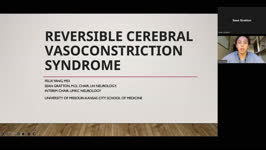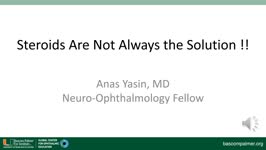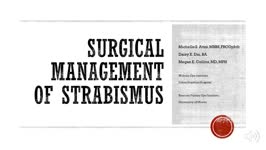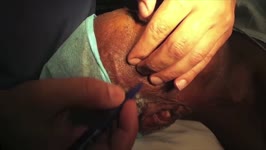Collection of materials relating to neuro-ophthalmology as part of the Neuro-Ophthalmology Virtual Education Library.
NOVEL: https://novel.utah.edu/
TO
- NOVEL226
| Title | Creator | Description | Subject | ||
|---|---|---|---|---|---|
| 176 |
 |
Pupils Light Near Dissociation | Karl C. Golnik, MD | This narrated presentations describes light near dissociation. | Pupil; Light Near Dissociation |
| 177 |
 |
Radiation Optic Neuropathy | Khawla Elnour; Amanda Henderson, MD | A video describing optic neuropathy related to radiation. | Radiation; Neuropathy |
| 178 |
 |
Raymond Cestan Syndrome | Srujay Pandiri; Sean Gratton | This is a brief narrated powerpoint that explains the clinical presentation of Raymond Cestan Syndrome. This is a rare brainstem stroke syndrome that presents with ipsilateral internuclear ophthalmoplegia and contralateral hemiparesis as well as other features. It is sometimes referred to as upper d... | Brainstem Stroke Syndromes; Internuclear Ophthalmoplegia; Pons |
| 179 |
 |
Red Color Desaturation | Sean Gratton, MD | Exploring red color desaturation. | Red Color Desaturation |
| 180 |
 |
Refraction | Sean Gratton, MD | An introduction to refraction. | Refraction |
| 181 |
 |
Retinal Artery Occlusive Disease | Ali Alkhabbaz, MD; James Brian Davis; Amanda Dean Henderson, MD | Retinal arterial occlusion includes ophthalmic artery occlusion (OAO), central retinal artery occlusion (CRAO), branch retinal arteriolar occlusion (BRAO), from proximal to distal. These can occur with or without retinal ischemia and may be permanent or transient. There are 4 subtypes of CRAO: non-a... | Branch Retinal Arteriolar Occlusion; Central Retinal Artery Occlusion; Giant Cell Arteritis; Ophthalmic Artery Occlusion |
| 182 |
 |
Retinal Venous Occlusive Disease | Ali Alkhabbaz; James Brian Davis; Amanda Dean Henderson | Retinal venous occlusion (RVO) includes central retinal vein occlusion (CRVO), hemi-central retinal vein occlusion (HCRVO), and branch retinal vein occlusion (BRVO). The most important risk factor for RVO is hypertension, but other risk systemic factors include advanced age and cardiovascular diseas... | Branch Retinal Vein; BRVO; Central Retinal Vein; CRVO; HCRVO; Retinal Venous Occlusion |
| 183 |
 |
Reversible Cerebral Vasoconstriction Syndrome (RCVS) | Felix Yang; Sean Gratton | This is a narrated powerpoint that reviews Reversible Cerebral Vasoconstriction syndrome. It discusses the diagnostic basics and evaluation and management. It compares RCVS to Posterior Reversible Encephalopathy Syndrome (PRES). | Primary Angiitis of the Central Nervous System; Reversible Cerebral Vasoconstriction Syndrome; Subarachnoid Hemorrhage; Thunderclap Headache |
| 184 |
 |
Right Lateral Medulla and Cerebellar Stroke | Jorge C Kattah, MD | This patient presented with an acute vestibular syndrome, he has a h-left beat nystagmus and a normal head impulse test . He had grade 3 truncal ataxia and severe ocular lateropulsion to the right (type 1 overt OL). Hypometric leftward, centripetal, slow saccades were video-recorded even six weeks... | Right Lateral Medulla; Cerebellar Stroke |
| 185 |
 |
See-Saw Nystagmus | Raed Behbehani, MD | See-saw nystagmus is a localizing nystagmus to lesions of the sellar and parasellar region. "It's characterized by synchronous elevation and intorsion of one eye and depression and extorsion of the contra lateral eye . This patent has a craniopharyngioma, which was operated twice, optic atrophy and ... | See-Saw Nystagmus |
| 186 |
 |
See-Saw Nystagmus | Raed Behbehani, MD | This nystagmus localizes to lesions supra/parasellar region (Large sellar and hypothalamic lesion) and is characterized by a see saw movement of elevation/intorsion of one eye and depression/extorsion of the other eye in a pendular fashion. This patient had a large pituitary macro-adenoma with supra... | See-Saw Nystagmus |
| 187 |
 |
Selective Saccadic Palsy After Cardiac Surgery | Nilan D. Schnure, MD; Ali G. Hamedani, MD, MHS; Grant T. Liu, MD | A unique gaze palsy selectively affecting saccades while sparing smooth pursuit, vergence, and vestibular reflex eye movements has been described following uncomplicated cardiac (and especially ascending aortic) surgery . This 69 year-old man reported persistent visual complaints immediately after a... | Saccade; Saccadic Palsy; Cardiac Surgery |
| 188 |
 |
Sensation from the Body: Neuroanatomy Video Lab - Brain Dissections | Suzanne S. Stensaas, PhD | Sensation consists of various modalities, which tend to travel in one of two pathways. The Anterolateral System also known as the Spinothalamic Tract carries pain and temperature. The Dorsal Column-Medical Lemniscus Pathway carries vibration, joint position, and fine 2-point discrimination. Light or... | Spinothalamic Tract; Anterolateral System; Dorsal Column-Medical Lemniscus Pathway; Body Sensation' Brain' Dissection |
| 189 |
 |
Sensation from the Face: Neuroanatomy Video Lab - Brain Dissections | Suzanne S. Stensaas, PhD | Sensation from the face travels in one of two pathways both of which eventually converge to form the trigeminothalamic tract that reaches the thalamus. The tract that carries pain and temperature is confusing because it first descends before crossing while the equivalent of Dorsal Column-Medical Lem... | Brain; Dissections |
| 190 |
 |
Sensory Nystagmus | Tony Brune, DO; Jonathan D. Trobe, MD; Raed Behbehani, MD | A video describing sensory nystagmus. | Nystagmus; Sensory Nystagmus |
| 191 |
 |
Serial Examination and Evolution of Horizontal Gaze Palsy in Thiamine Deficiency | Maxwell Nyce, OD; Joshua Chisholm, OD; Julia Szmada, OD; Jorge C Kattah, MD | Neurology consult of patient with hearing loss following vertical band sleeve gastroplasty. See associated presentation: https://collections.lib.utah.edu/details?id=1512437 | Gaze Palsy; Gaze Paretic Nystagmus; Vestibular Loss; Hearing Loss; Loss of Speech Comprehension; Encephalopathy |
| 192 |
 |
Sixth nerve palsy or not? (Video) | Vivian Paraskevi Douglas; Konstantinos Douglas; Nurhan Torun | Here in we present a case of a 72-yearold Caucasian female with remote history of breast cancer who presented with diplopia in the right gaze over the past several months. There had been no improvement after a 5-day course of steroids by an outside ophthalmologist. On neuro-ophthalmic examination, t... | Abduction deficit; Diplopia; Orbital imaging |
| 193 |
 |
Sports Related Head Injuries | Jessica Darusz, MD; Sean Gratton, MD | This narrated PowerPoint reviews the basics of sports related head injuries. It emphasizes assessment tools and treatment decisions in assessing athletes with concussion and other head injuries. | Concussion; Sports-related Head Injuries; Post-concussion Syndrome |
| 194 |
 |
Square Wave Jerks with Contrapulsion | Raed Behbehani, MD | A patient with history of brain stem stroke 2 months ago (right hemifacial anesthesia , left sided weakness and bulbar symptoms dysphagia) comes complaining of oscillipsia , binocular vertical diplopia). On exam he had a vertical tropia of 3-4 PD (Skew deviation), dissociated nystagmus , and saccadi... | Square Wave Jerks; Contrapulsion |
| 195 |
 |
Steroids Are Not Always the Solution!! | Anas Yasin, MD | Leber Hereditary Optic Neuropathy (LHON) is the most common inherited mitochondrial disorder and typically affects young males. (https://eyewiki.aao.org/Leber_Hereditary_Optic_Neuropathy) | Leber Hereditary Optic Neuropathy (LHON) |
| 196 |
 |
Superonasal Transconjunctival Optic Nerve Sheath Decompression (stONSD) | Kevin E. Lai, MD; Kenneth C. Lao, MD; Peter L. Hildebrand, MD; Bradley K. Farris, MD | This video demonstrates the surgical technique and outcomes of a modified medial transconjunctival approach to optic nerve sheath decompression (ONSD). Disease/Diagnosis: Papilledema; Idiopathic Intracranial Hypertension (IIH). | Superonasal Transconjunctival Optic Nerve Sheath Decompression (ONSD); Surgical Technique |
| 197 |
 |
Surgical Management of Strabismus | Michelle S. Attzs, MBBS, FRCOphth | This is a brief introduction to the surgical management of strabismus. It includes the key elements of the work up for a patient about to undergo strabismus surgery, introduces the basics on surgical techniques including adjustable sutures, and discusses the complications associated with this surger... | Strabismus; Surgery; Ocular Motility; Adjustable Sutures; Esotropia; Exotropia; Complications |
| 198 |
 |
Temporal Artery Biopsy | Raed Behbehani, MD | This is a video of Superficial Temporal Artery Biopsy done under local anaesthesia for a patient who was suspected to have Giant Cell Arteritis (GCA. GCA is vasculitis of the medium sized vessels than can lead to permanent visual loss by causing Arteritis Ischemic Optic Neuropathy. The diagnosis of ... | Temporal Artery Biopsy; Giant Cell Arteritis |
| 199 |
 |
Temporal Artery Biopsy Procedure | Nooran Badeeb; Danah Albreiki | Temporal artery biopsy is a procedure that is done in a patient with suspicion of GCA (Giant cell Arteritis), and some of the clinical manifestations that prompts us to suspect the diagnosis in patients older than 50 years old are: 1. GCA symptoms e.g. new onset headache. 2 . Visual symptoms: - Visi... | Temporal Artery Biopsy; GCA; Temporal Arteritis |
| 200 |
 |
The Meninges: Neuroanatomy Video Lab - Brain Dissections | Suzanne S. Stensaas, PhD | The epidural, subdural and subarachnoid spaces are demonstrated and discussed with respect to trauma and disease. The relationship of the brainstem and cerebellum to the tentorium demonstrates the vulnerability of the brain stem to increased supratentorial pressure and herniation. Arachnoid granulat... | Meninges; Brain; Dissection |
